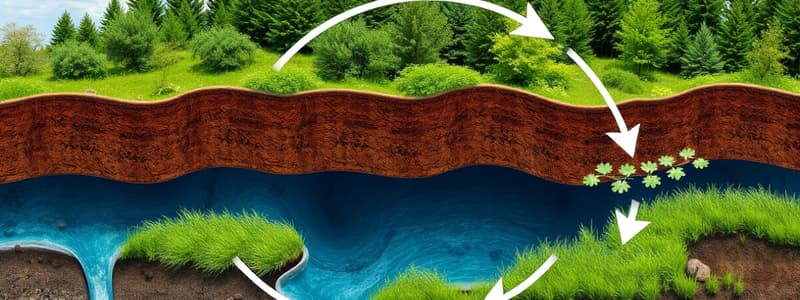Podcast
Questions and Answers
What critical chemical reaction do plants perform to convert sunlight into energy?
What critical chemical reaction do plants perform to convert sunlight into energy?
- Respiration
- Fermentation
- Photosynthesis (correct)
- Oxygeneous respiration
Which of the following inputs are essential for photosynthesis?
Which of the following inputs are essential for photosynthesis?
- Soil and minerals
- Nitrogen and hydrogen
- Methane and carbon monoxide
- Sunlight, water, and carbon dioxide (correct)
What process ultimately results in the formation of fossil fuels?
What process ultimately results in the formation of fossil fuels?
- Natural refinement under pressure and temperature (correct)
- Rapid decomposing of organic matter in open air
- Chemical reactions involving sunlight
- Biochemical breakdown by bacteria
What key element is primarily responsible for energy storage in plants before it becomes fossil fuels?
What key element is primarily responsible for energy storage in plants before it becomes fossil fuels?
How did the discovery of fossil fuels impact human society?
How did the discovery of fossil fuels impact human society?
How do carbon compounds primarily contribute to human prosperity?
How do carbon compounds primarily contribute to human prosperity?
What role does carbon dioxide (CO2) play in the environment?
What role does carbon dioxide (CO2) play in the environment?
Which of the following describes carbon's structural versatility?
Which of the following describes carbon's structural versatility?
What effect did the Industrial Revolution have on human populations?
What effect did the Industrial Revolution have on human populations?
What does the flexibility of carbon allow it to do?
What does the flexibility of carbon allow it to do?
How does carbon primarily contribute to the food chain?
How does carbon primarily contribute to the food chain?
What significant impact did the manipulation of carbon cycles have on human civilization?
What significant impact did the manipulation of carbon cycles have on human civilization?
What is a consequence of carbon's ability to form strong bonds with other atoms?
What is a consequence of carbon's ability to form strong bonds with other atoms?
What role does carbon play in the sustenance of human prosperity?
What role does carbon play in the sustenance of human prosperity?
Which characteristic of carbon allows it to become a key agent in technological advancements?
Which characteristic of carbon allows it to become a key agent in technological advancements?
What role do fossil fuels play in the carbon cycle?
What role do fossil fuels play in the carbon cycle?
How are carbon atoms transferred along the food chain?
How are carbon atoms transferred along the food chain?
What significant event occurred during the Carboniferous Period regarding carbon molecules?
What significant event occurred during the Carboniferous Period regarding carbon molecules?
Which process contributes to the creation of concentrated fossil fuels?
Which process contributes to the creation of concentrated fossil fuels?
What do fossil fuels represent in terms of carbon transformation?
What do fossil fuels represent in terms of carbon transformation?
What is a consequence of the fossil fuel extraction on society?
What is a consequence of the fossil fuel extraction on society?
Which statement best describes the impact of buried carbon on fossil fuel formation?
Which statement best describes the impact of buried carbon on fossil fuel formation?
Flashcards are hidden until you start studying
Study Notes
The Carbon Cycle and Human Prosperity
- Understanding and manipulation of carbon and nitrogen cycles have propelled human prosperity.
- Discovery and extraction of hydrocarbons sparked the Industrial Revolution, enabling unprecedented economic growth.
- Carbon is fundamental to life, forming strong bonds and diverse molecules, essential for energy transfer.
Properties and Importance of Carbon
- Carbon can form both robust materials (diamonds) and weak materials (graphite).
- Acts as a key component in power generation, food supply, and overall economic structure.
- Carbon transitions through the food chain, promoting life and supporting apex predators.
Role of Carbon Dioxide
- Carbon dioxide (CO2) is vital for life; plants absorb CO2 and release oxygen (O2) through photosynthesis.
- Photosynthesis is the process where plants convert sunlight, water (H2O), and carbon dioxide (CO2) into stored energy and sugars.
- Carbon atoms circulate through the food chain, enhancing the survival and prosperity of various species.
Carboniferous Period and Fossil Fuels
- The Carboniferous Period began around 400 million years ago when some carbon molecules evaded consumption.
- Carbon was buried in swamps and ocean beds, avoiding oxygen exposure and predation, leading to fossil fuel formation.
- The natural refinement of carbon under Earth's pressure and temperature resulted in the creation of coal, oil, and natural gas.
Impact of Fossil Fuels on Society
- Fossil fuels represent concentrated hydrocarbons, acting as energy storage derived from centuries of photosynthesis.
- Exploitation of these energy resources has significantly influenced societal advancement over the last two centuries.
- The availability of fossil fuels created a new energy surplus equation, drastically transforming human civilization.
The Carbon Cycle and Human Prosperity
- Understanding and manipulation of carbon and nitrogen cycles have propelled human prosperity.
- Discovery and extraction of hydrocarbons sparked the Industrial Revolution, enabling unprecedented economic growth.
- Carbon is fundamental to life, forming strong bonds and diverse molecules, essential for energy transfer.
Properties and Importance of Carbon
- Carbon can form both robust materials (diamonds) and weak materials (graphite).
- Acts as a key component in power generation, food supply, and overall economic structure.
- Carbon transitions through the food chain, promoting life and supporting apex predators.
Role of Carbon Dioxide
- Carbon dioxide (CO2) is vital for life; plants absorb CO2 and release oxygen (O2) through photosynthesis.
- Photosynthesis is the process where plants convert sunlight, water (H2O), and carbon dioxide (CO2) into stored energy and sugars.
- Carbon atoms circulate through the food chain, enhancing the survival and prosperity of various species.
Carboniferous Period and Fossil Fuels
- The Carboniferous Period began around 400 million years ago when some carbon molecules evaded consumption.
- Carbon was buried in swamps and ocean beds, avoiding oxygen exposure and predation, leading to fossil fuel formation.
- The natural refinement of carbon under Earth's pressure and temperature resulted in the creation of coal, oil, and natural gas.
Impact of Fossil Fuels on Society
- Fossil fuels represent concentrated hydrocarbons, acting as energy storage derived from centuries of photosynthesis.
- Exploitation of these energy resources has significantly influenced societal advancement over the last two centuries.
- The availability of fossil fuels created a new energy surplus equation, drastically transforming human civilization.
Studying That Suits You
Use AI to generate personalized quizzes and flashcards to suit your learning preferences.




